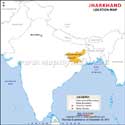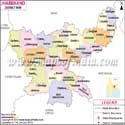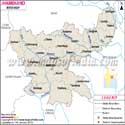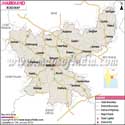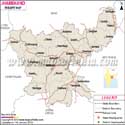
| Disclaimer: All efforts have been made to make this image accurate. However Mapping Digiworld Pvt Ltd and its directors do not own any responsibility for the correctness or authenticity of the same. |
Jharkhand is a newly formed state of eastern India; it borders with Uttar Pradesh and Chhattisgarh in the west, Bihar in the North, Odisha in the south and Indian state of West Bengal in the east. It became an independent state in the year 2000, after splitting from Bihar. Ranchi, the capital is a well known industrial and academic city of Jharkhand.
Jharkhand is known as a mining and industrial heaven of India with Jamshedpur, Bokaro and Dhanbad as the highly industrialized cities of eastern India. Jharkhand is endowed with thick forest, mines and natural beauty. That is the reason, it is considered to be a wealthy state with skilled workforce, abandoned mineral wealth and forestry produces.
Its cover of thick forests is the natural habitat of a big number of tigers and Indian elephants. The meteorological department calls it the Chhota Nagpur plateau. Jharkhand is the origin of various rivers such as Koel, Damoder, Brahamani, Kharkai and Subarnarekha. Known for its rich flora and fauna, it is home to various national parks and the zoological gardens.
Jharkhand's population is 27 million with a good "male to female ratio." Around one third of its population is tribal. There are as many as 35 primitive tribal groups in Jharkhand.
Jharkhand has seen a lot of migration from the neighboring states of West Bengal and Bihar majorly for employment. In this ancient state, tribal communities do not follow Hinduism; they have their own spirituals beliefs called as Sarna.
As discussed earlier Jharkhand is the goldmine of minerals and ores such as iron ore, copper ore, mica, coal, bauxite, manganese, fireclay, china clay, lime stone, kainite, graphite, chromites, uranium, thorium, asbestos, gold, silver and yemenite. In the production of some of these minerals and ores, Jharkhand ranks among top three states of India.
Despite its huge industrial growth and minerals resources, the people are still poor and the civic infrastructure and amenities in the state are substandard. It is largely because of the poor governance and corruption in politics. Annual per capita income is also very low. Jharkhand has 22 districts and it is run by a state government based in Ranchi, which is assisted by a lobby of IAS officers.
After sweeping colonization, followers of others religions such as Hinduism, Islam and Christianity also settled here, but tribal faith Sarna is still growing. Bhojpuri, Hindi, Bengali, and Urdu are the major languages spoken, whereas the tribal people also speak Kharia, Paharia, Bhumij, Mundari, Santhali and Ho. Some of the Dravidian languages such as Oraon and Korwa are also spoken here.
Jharkhand State Information |
|
|---|---|
| Capital | Ranchi |
| Date of formation | 15. Nov. 2000 |
| Governor | Draupathi Murmu |
| Chief Minister | Raghubar Das |
| Tourist attractions | Dassam Falls, Sun Temple, Birsa Zoological Park, Jamshedpur Industrial Area |
| Festivals | Basant Panchami, Chhat Puja |
| Major dance and music forms | Agni and Jhumar dances |
| Arts and crafts | Large colourful masks made from the dark clay taken from the banks of the River Khakai; Jadu Patua is a form of scroll painting. |
| Languages | Hindi, Urdu, Santhali |
| Size | 79,714 sq. km |
| Population (Census 2011) | 32,388,134 |
| Rivers | Aon, Kosi, Ghagra |
| Forests and wildlife sanctuaries | Betla (Palmau) NP, Hazaribagh Wildlife Sanctuary |
| State animal | Elephant |
| State bird | Asian koel |
| State flower | Palash |
| State tree | Sal |
| Major crops | Paddy, wheat, maize |
| Factoids | Dhanbad is also known as India's coal capital. |
| Jharkhand's original inhabitants, the adivasis, revolted against British exploitation of their forests. | |
| No. of District | 24 |
